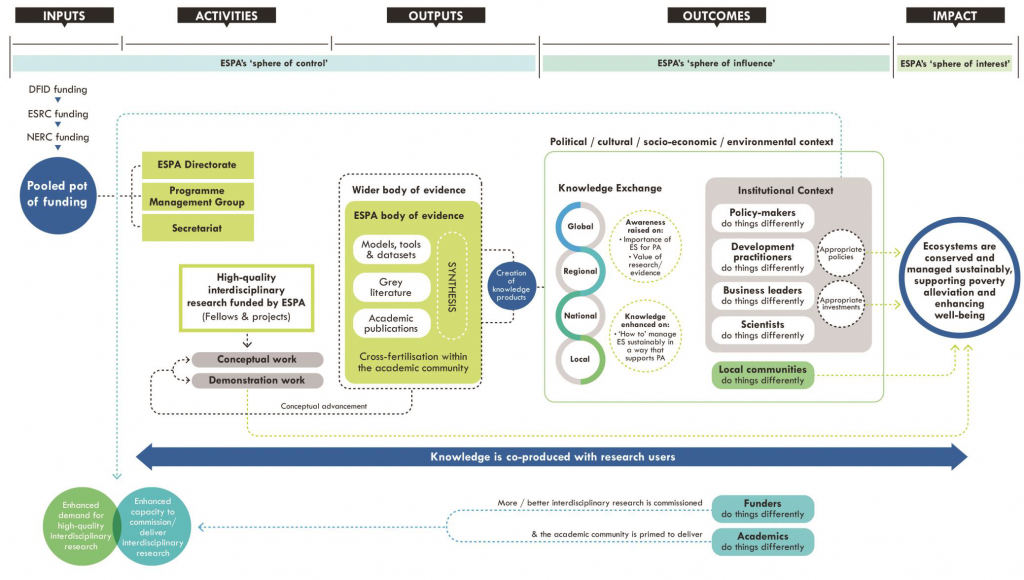Monitoring, Evaluation and Learning (MEL) are a set of tools or approaches which are increasingly being applied to research. The approaches that I have used were derived from those developed for the international development sector starting with logical frameworks which were common from the early 1990’s onwards.
The way that monitoring and evaluation tends to be used in the research context is as a process to enhance the effective implementation of projects, along with collecting evidence of the impact of research. The learning component of MEL is designed to learn lessons from projects that contribute to both research uptake and improving the design and implementation of future projects.
There are numerous ways to implement monitoring, evaluation and learning and a few relevant links are provided here:
- European Union (Research and Innovation programmes);
- UKRI Measuring success;
- DFID’s Evaluation Strategy 2014-19;
- International Initative for Impact Evaluation (31e).
The following sections provide some practical examples and outcomes from projects that I have led during my career.
 Darwin Initiative
Darwin Initiative
The Darwin Initiative was announced by the UK Government at the 1992 Rio Earth Summit. Its first projects were funded in 1993 and since then well over 1000 projects have been funded in over 150 countries. By early 2020, the Initiative had allocated over £166 million in funding.
The UK Government needed evidence of the value generated by the programme and synthesis of outcomes and lessons learnt that could be shared with others, including the Convention on Biological Diversity (CBD). For this reason a monitoring, evaluation and learning programme was established in the late 1990s and has continued to date. I was involved in this process for almost ten years and co- led the development of the approaches that remain the basis of the system used today
There were three main components/activities:
- Capturing information. This came through a combination of reporting requirements and external reviews by technical experts.
- Synthesis of information. This was facilitated by new data management systems, including the Darwin Information System launched in 2007 and a series of structured reviews involving both desk activities and field reviews.
- Communicating results. A variety of formats and modes of communication ranging from traditional reports through to enhanced websites, blogs and social media.
The Darwin Initiative published a summary document describing their approach to monitoring and evaluation in 2015.
As the technical lead for the Initiatives Monitoring and Evaluation activities I applied the system in a wide range of countries and contexts. Examples of this are described as examples of research communication on this website.

Ecosystem Services for Poverty Alleviation Programme (ESPA)
The ESPA programme was launched in 2010 and ran up to 2018. At the time of its launch, it was the UK Government’s largest investment in global research linking environment and society.
As the inaugural ESPA Director, one of the immediate priorities for my team was to develop an approach to monitoring, evaluation and learning before new projects were commissions. The approach developed for ESPA, was based on the systems used by the Darwin Initiative and then adapted to meet the needs of a much larger and diverse programme. ESPA’s primary focus was on the production of new research, knowledge and tools and required greater emphasis on academic publications. ESPA also was required to use standard reporting systems (Researchfish) provided by the UK Research Councils, supplemented by custom reports developed for ESPA.
ESPA’s approach to MEL meant that much more could be learnt and communicated at programme level. The ESPA website provided detailed information about projects, their publications, researchers and partnerships as well as summaries of evidence and impacts generated by projects. This level of integrated information differs significantly from the standard public reporting for research funded by the UK Government, through the Gateway to Research
ESPA was an early adopter of a new tool for MEL with work on a Theory of Change that started being applied at both programme and project level from 2012 with the publication of the ESPA guide to working with Theory of Change for research projects.

There was generally positive feedback from both projects teams and ESPA’s funders leading to enhanced uptake at the programme developed. ESPA’s 2016 Impact Strategy was the last produced by the programme and included further refinements on the programme Theory of Change.

 University of Leicester
University of Leicester
As Deputy-Pro-Vice-Chancellor for International and Development Research at the University of Leicester, I was responsible for leading the development and implementation of institutional strategies for global research.
Leicester modified the approach I had developed for ESPA and started applying the concepts of monitoring, evaluation and learning to their development research.
Leicester’s Strategy for GCRF funded Research was evaluated by Research England in 2018 and was one of only ten institutions in England that were highlighted as having exemplary practice at that time. Leicester’s adoption of theory of change practice has highlighted as a strength.
The University of Leicester continues to develop this approach and a new theory of change is expected to be published later in 2020. The University if also now exploring the potential to expand this practice to be used for all research that addresses major research challenges, not just for research in developing countries.